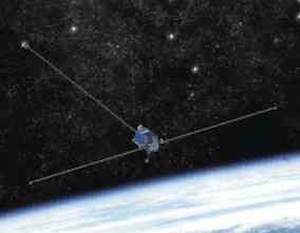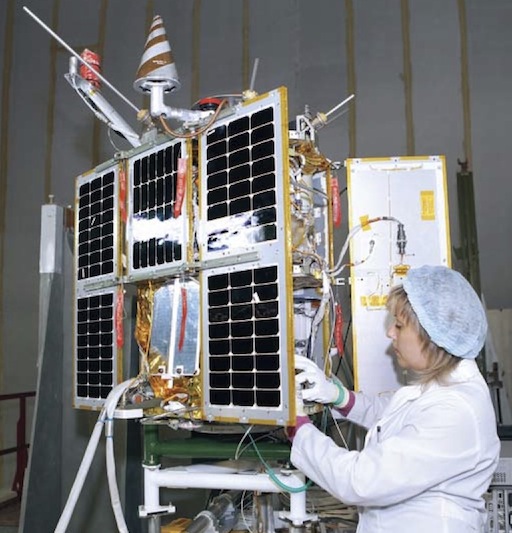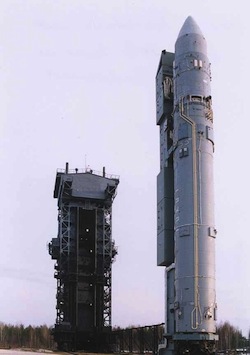Yubileiny-2 (MiR)
 The small spacecraft MiR (Yubileiny-2) is one of them. The satellite was named after Mikhail Reshetnev, the founder and the first director of the company. The previous satellite for scientific purposes – Yubileiny – was placed into orbit in 2008 and since then it has exceeded the designed lifespan by three times and now is still carrying out its mission. ISS-Reshetnev has recently completed MiR, and the satellite is to be inserted into LEO with the next launch of a Rockot vehicle.
The small spacecraft MiR (Yubileiny-2) is one of them. The satellite was named after Mikhail Reshetnev, the founder and the first director of the company. The previous satellite for scientific purposes – Yubileiny – was placed into orbit in 2008 and since then it has exceeded the designed lifespan by three times and now is still carrying out its mission. ISS-Reshetnev has recently completed MiR, and the satellite is to be inserted into LEO with the next launch of a Rockot vehicle.
Academician M.F. Reshetnev Information Satellite Systems constantly develops new solutions for space technologies. The small spacecraft MiR (Yubileiny-2) is one of them. The satellite was named after Mikhail Reshetnev, the founder and the first director of the company. The previous satellite for scientific purposes – Yubileiny – was placed into orbit in 2008 and since then it has exceeded the designed lifespan by three times and now is still carrying out its mission. ISS-Reshetnev has recently completed MiR, and the satellite is to be inserted into LEO with the next launch of a Rockot vehicle.
Mission
The research satellite MiR enables testing new advanced technological solutions introduced by ISS‐Reshetnev and a number of its associate companies. In particular, MiR is to be used for effectiveness verification of the following structures and components: contoured heat pipes, new technological enhancements for onboard radio equipment and small‐sized sensitive, high‐precision elements of AOCS (including small‐sized magnetic torquers for satellites’ AOCS). These tests would contribute to the further technological enhancement and development of satellites yet to be designed. A number of experimental instruments for the MiR satellite have been manufactured with the participation of students and research members from Siberian State Aerospace University (SibSAU). The company closely collaborates with this university, allowing students to be involved in the process of satellite production. The research and education center “Space systems and technologies” held by ISS and SibSAU, and joint activities under the MiR project provide extensive training and hand‐on experience for talented young people, who in near future might work for the Reshetnev Company.
Some instruments designed and pro‐ duced in tandem with SibSAU are used for testing the remote earth sensing technology, in particular, it is a camera intended for observing the earth sur‐ face. Nowadays ISS‐Reshetnev pays great attention to developing the re‐ mote sensing technology. The payload also includes a small WeB‐camera – an important in‐ strument enabling ISS specialists to continuously observe the satellite’s deployment mechanisms and moni‐ tor the performance of satellite com‐ ponents, structures and instruments made of advanced composite materials. In‐orbit performance data will be ana‐ lyzed and referred to in the manufac‐ ture of next‐generation satellites. The new satellite is also tasked with testing the optical properties of solar concentrators, using an experimental solar panel module. In addition to this, a compact navigation receiver installed in MiR (intended to obtain the spacecraft’s orbit parameters using the GLONASS and GPS technology) will also undergo flight tests. The MiR satellite will fulfill its orbital mission in the circular low earth orbit. The designed active lifespan of the spacecraft is one year. The satellite’s mass is 65 kilograms. It is expected that MiR will be launched by a Rockot vehicle from the Plesetsk Cosmodrome. Due to the satellite’s mall dimensions it will be inserted into orbit as a hosted payload.
 Uplink
Uplink
145 MHz
Downlink
435 MHz
Status
To be launched with a Rockot around July 27, 2012. At the moment there are some problems with the Briz-KM Upper Stage of the Vehicle.
